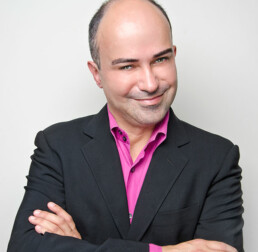
A chemical peel is as basic as getting your teeth cleaned at the dentist’s office
What you’re about to hear may prove fatal to the arsenal of creams, lotions, gels, emollients and other lubricants you’ve been applying to your face since you were 18. After years of slathering, greasing and creaming, you may be astonished at this advice from Manhattan aesthetician, Claudio Pinto: “Moisturizing is one of the worst things you can do to your skin.”
“No, that’s ridiculous,” you’re thinking, especially since you probably just invested in the be-all-end-all emollient, promising to deliver velour-texturized dewiness, making you as irresistible as an ice cream cone in August.
The secret mission you’ve been on your entire life – the quest for beauty – demands that you put your doubts aside and listen up. Remember when you thought estrogen was the key to eternal youth and a “high colonic” purge was the road to mecca? Do you remember when margarine was considered healthy? The road to beauty leads to many dead ends. Women with backbone cut their losses, trim their dead ends and, in this case, peel off the old to reveal luminous skin.
According to New York aesthetician, Claudio Pinto, “Women have been told to moisturize since they were children. This is why more and more women claim to have ‘sensitive skin.’” Further, women love to apply more and more products, which in turn, block pores and prevent natural skin renewal from taking place. Healthy skin doesn’t need moisturizer because all layers of the skin work properly and are free of free-radical and environmental damage.”
Instead of moisturizing, Pinto says “peel,” no matter who you are and regardless of your skin condition or concern. A peel removes damaged skin cells, speeding up cell renewal to reveal a healthier complexion. You can think of a chemical peel the same way you think about a professional dental cleaning.
The thickness of your skin is one of the things an aesthetician looks at first. “Normally, thicker, oily or combination skin can pretty much tolerate anything. With thick-skinned patients you want to be aggressive so they can really see results. Thinner-skinned patients do better with soothing, gentle treatments – more hyaluronic acid and less penetrating acids. But, they are still coming to a medical office to see results!”
Pinto recommends two medical grade FDA-approved peels. “The Perfect Peel,” a combination of trichloracetic acid (TCA), phenol, salicylic acids, vitamin C and retinol is one-stop shopping for the complexion that claims to do everything except make your car run. It promises to eliminate acne, melasma, and hyperpigmentation; reverse signs of aging, age spots and sun damage; erase acne scarring and blemishes; lighten and brighten skin; reduce pore size and soften fine lines and wrinkles, stimulating collagen production. It is especially beneficial if you have oily/combination/acne prone skin. Phenol numbs the skin, making the peel tolerable for all. Downtime starts on day three and ends on day six. Pinto says, “This treatment is more potent than pretty much any peel out there, without the associated pain, high price or downtime.” Caution: this is not a do-it-yourself treatment. If you see it on eBay, do not purchase.
If you want a much gentler treatment, Pinto says “Obagi Blue Peel Radiance,” provides superficial exfoliation and refreshes the skin without actually causing it to peel. This peel is so gentle that if there’s any reaction at all it is a light redness that will last for about 30 minutes. But, if you are looking for dramatic results or transformation, this is not your answer. Obagi provides tighter, smoother, brighter-looking skin after just one peel, but a series of four to six peels provides best overall results. For more dramatic results, you would need about six treatments. Obagi can be used in between more aggressive peels or microdermabrasion treatments. It is ideal if you have an event or want your skin to look better and healthier without actually peeling.
As a compliment to any skin care system, Pinto adds Retin-a, the most tried and true beauty elixir on the planet. “I have been treating patients with Retin-a for 15 years and start new patients on Retin-a every other night until, ideally, they use it every night. We have Retin-a in various concentrations and now we have Refissa for patients that have not been able to tolerate Retin-a. Retin-a is the number one prescription treatment and I recommend it highly to everyone, every day, regardless of age or skin condition. It’s the workout for the skin.”
After spending precious dollars on a peel and a good homecare, the biggest mistakes you can make, according to Pinto, are 1) not to wear sunscreen daily and B) to mix and match the recommended prescription skincare with everything else you have at home. “There’s a reason to do what we do. Formulations are made to work in synergy.”
Final advice, “Do not cover your skin with layers of foundation. An aesthetician can help find the correct products and formulations to clear your skin.”
